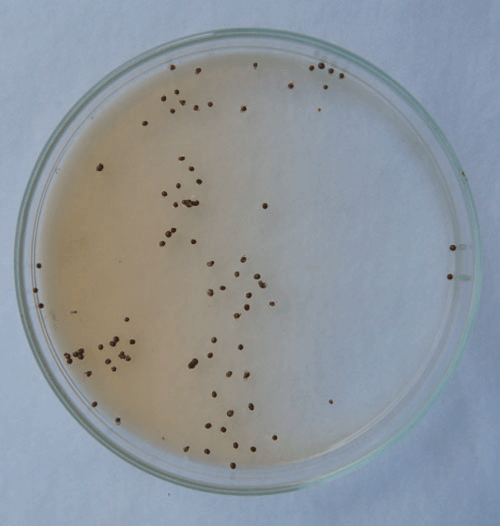Basal rot of arum lily (Zantedeschia aethiopica) caused by Sclerotium rolfsii in Brazil
E. R. Mesquita A , O. L. Pereira B C and J. A. S. Grossi AA Departamento de Fitotecnia, Universidade Federal de Viçosa, Viçosa, M.G. 36570-000, Brazil.
B Departamento de Fitopatologia, Universidade Federal de Viçosa, Viçosa, M.G. 36570-000, Brazil.
C Corresponding author. Email: oliparini@ufv.br
Australasian Plant Disease Notes 2(1) 91-92 https://doi.org/10.1071/DN07037
Submitted: 16 April 2007 Accepted: 31 May 2007 Published: 14 June 2007
Abstract
Basal rot caused by Sclerotium rolfsii is reported for the first time on Zantedeschia aethiopica in Brazil.
Zantedeschia aethiopica (arum lily – local name: copo-de-leite) is an herbaceous plant that belongs to the Araceae, and is native to South Africa. It is widely used for ornamental purposes, and in Brazil it is considered among the most important species for the cut flower industry (Lorenzi and Souza 1995). In December 2006, a severe basal rot was observed on Z. aethiopica grown in a garden nursery in Viçosa (state of Minas Gerais, Brazil). Symptoms first appeared as yellowing and drooping of leaves, with wilting of plants and a thin white cottony mycelial growth at the collar region. On the diseased areas, small brown spherical sclerotia were observed, associated with the rotting tissue (Fig. 1). The fungus was isolated on V8 juice agar directly from diseased tissue. In the culture, the isolate had the following morphology: hyphae white, branched, 1.5–3.0 μm diameter, with clamp connections. Sclerotia smooth, spherical to ellipsoidal, light brown becoming dark brown with age, 0.5–2.0 mm diameter (Fig. 2). Based on morphological characteristics the fungus was identified as Sclerotium rolfsii (Punja 1985). A representative specimen was deposited at VIC herbarium (code register: VIC 30448). Pathogenicity was tested by placing a Parafilm-wrapped V8 juice agar plug bearing both mycelium and sclerotia near the collar region of healthy arum lily plants. After 6 days, yellowing of basal leaves, followed by drooping of leaves and wilting was observed on inoculated plants. The non-inoculated control plants, on which V8 juice-agar plugs were deposited, remained healthy. Sclerotium rolfsii was reisolated from inoculated plants.

|

|
Mendes et al. (1998) listed no fungal diseases of Z. aethiopica in Brazil. Vieira and Barreto (2004) reported Cercospora richardiicola (= Cercospora apii s. lat.) as causing leaf spots on Z. aethiopica in this country. Sclerotium rolfsii is a cosmopolitan pathogen of many cultivated crops and weeds (Punja 1985), but it has only been reported on Z. aethiopica in the USA (Farr et al. 1989). This is the first report of S. rolfsii on Z. aethiopica in Brazil.
Punja ZK
(1985) The biology, ecology and control of Sclerotium rolfsii. Annual Review of Phytopathology 23, 97–127.

Vieira BS, Barreto RW
(2004) First record of Cercospora richardiaecola causing leaf spots on Zantedeschia aethiopica in Brazil. Plant Pathology 53, 813.
| Crossref | GoogleScholarGoogle Scholar |



